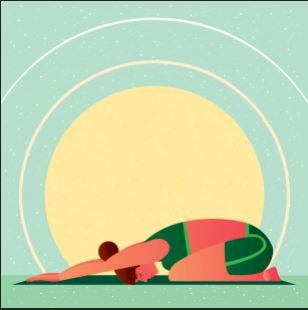|
Last week Manush had us go into deep relaxation in child’s pose instead of shivasana, which I found uniquely opening and relaxing. It was particularly effective for a mindful sort of letting go, especially after the more advanced Kriya Manush offered that day, and I noticed how deeply restored I felt afterward. I remember my sister, as a child, spent a lot of time in child's pose, it seemed to soothe her, to make her feel safe and secure, especially after something physically, mentally or emotionally trying. Both adults and children like to relax and recover in child's pose; it is such a natural pose that allows the overworked adrenal gland area to uncontract, stretch open and decompress so we can really rest and renew. Along with being restorative and comforting, I can always feel this pose opening up my gluts, hips, lower back, and really the entire back and shoulders when my arms are stretched forward. All the energy and blood flow is naturally directed to the third eye as the forehead rests on the mat. Let's face it, we need our third eye in today's world, now more than ever, to discern truth so we can form a strategic perspective from which to make the most optimal choices. Child’s pose, or balasana in Sanskrit, is a beginner’s yoga pose designed to relax the mind and body. The Sanskrit word bala, means “young or child-like,” and asana, means “yoga posture.” Child’s pose stretches the whole spine, the hips and thighs and even the ankles. When the arms are in a variation with the arms stretched forward, the wrists, elbows, shoulders and fingers get a profound stretch as well. Yoga mudra, a variation in which the hands are clasped behind the back then raised up as high as possible while in child’s pose, stimulates all the acupuncture meridians in the arms, shoulders and chest, including the all important lung meridian for immune strength. Deep breathing is encouraged in this pose, so whether you’re an experienced yogi or brand new to the practice, it serves to reduce fatigue and anxiety, encourages a tranquil mind, and lets the nervous system relax. The tension relief is profound, especially throughout the quads, hamstrings, chest, shoulder and back and this relaxation radiates out to every other part of the body. Child’s pose increases blood circulation to the head and therefore to the pituitary, thalamus and pineal glands and that’s why it’s included in kriyas for the glands of the head. Because the pituitary gland is considered the master gland, the entire endocrine system also benefits. The increased blood flow to the brain means better memory and mind function, including better communication and comprehension. Who among us can't greatly benefit from that? Child’s pose is famous for improving digestion and elimination because a slight compression of the abdomen stimulates all the abdominal nerves and subtle channels. he legs can be widened to leave room for the belly and deep belly breaths in this pose, which deepens relaxation while activating digestion. We sometimes encourage props in child’s pose if we know someone has had an injury or other challenge, especially to the hip or knee: A rolled towel below your shins, to take the weight off the ankles, or a blanket, pillow, bolster or just your hands beneath your forehead can help the whole body relax. I find that making a pillow for my head with my hands, with closed eyes, consciously relaxing the jaw and the back of the head where it meets the neck, really helps the entire body relax. If you feel pain anywhere in the body, just sit up and take a break. If your hip joints are tight, consider keeping your knees together and lowering your torso on top of your thighs with your arms beside or in front of you. For a more passive pose, let your arms relax behind you, palms up, and rest the torso with your abdomen between your thighs. Use caution when practicing child’s pose if you’ve suffered a knee or hip injury or more recent surgery. As with all yoga poses, you may even want to ask your doctor or physical therapist before trying the pose. Occasionally, when my energy isn't up to par, or if I've been through something especially challenging, I may feel like spending the whole class recovering in Child's pose, and the beautiful thing about Kundalini Yoga is (if I'm not teaching) I will do just that! I know and feel that I am still benefitting from the inspiration and aspiration of everyone else I'm practicing with. In every class, we encourage each other to honor our mind, body and spirit, to be mindful of what you need right now, just as we are. We are together, not only to challenge each other, but to support and nurture each other with understanding and compassion. That's what I love most about Montclair Kundalini Yoga. Sending Love to all!
1 Comment
I wanted to express my gratitude for your insightful and engaging article. Your writing is clear and easy to follow, and I appreciated the way you presented your ideas in a thoughtful and organized manner. Your analysis was both thought-provoking and well-researched, and I enjoyed the real-life examples you used to illustrate your points. Your article has provided me with a fresh perspective on the subject matter and has inspired me to think more deeply about this topic.
Reply
Leave a Reply. |
Categories
All
|
Location127 Valley Road
Montclair, NJ |
|


 RSS Feed
RSS Feed